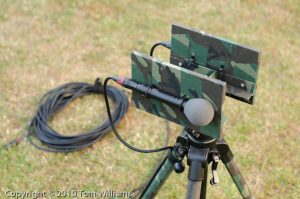A recent UK price drop meant I’ve finally been able to get my hands on a pair of Audio-Technica AT4022s – the successor to the AT3032 which has proved very popular amongst wildlife recordists for its low self-noise and affordable price.
The AT4022 is an omnidirectional microphone, meaning it is equally sensitive to sound from all directions. ((Theoretically anyway. In practice the response pattern becomes a little uneven at higher frequencies – see this diagram: http://eu.audio-technica.com/en/resources/e873eb8efe56cafc_at4022_polar.jpg)) Because of this, an ORTF set-up like I was using with the RØDE NT1As would deliver very little in the way of stereo. Instead I’ve mounted the microphones in a parallel boundary array, based on the work of Curt Olson and other contributors to the Naturerecordists Yahoo group (photos below).
These recordings are from a morning spent testing the new rig on the sand dunes at Dawlish Warren NNR. The microphones are connected to a Tascam HD-P2 recorder, and the only post-processing is a gain boost of around 20dB to save you turning up your speakers!
[soundcloud url=”http://soundcloud.com/pterodaktyl/whitethroat” params=”show_comments=true&auto_play=false&color=ff7700″ width=”100%” height=”81″ ]Whitethroat (Sylvia communis) [soundcloud url=”http://soundcloud.com/pterodaktyl/skylark” params=”show_comments=true&auto_play=false&color=ff7700″ width=”100%” height=”81″ ]Skylark (Alauda arvensis)Initial thoughts – the self-noise of the microphone is definitely more noticeable that that of the NT1As ((The AT4022 is rated at 13dB(A) self-noise as opposed to the 5dB(A) of the NT1A, one of the quietest consumer microphones available)) but the recordings have a far more natural feel. With the NT1As I always “knew” I was listening to a recording, whereas with a good set of headphones it’s possible to completely lose yourself in the AT4022 recordings and feel like you’re back in the field listening to the birds. My guess is this is partly down to the more even frequency response of the new microphones, along with the better stereo field created by the parallel boundary array.
The recordings were made on a fairly breezy morning, and the only protection on the microphones was the simple foam cover provided in the box. Aside from a few particularly strong gusts I had no trouble with wind noise while recording – another advantage of omnidirectional microphones which are typically much less sensitive to wind than cardioids.



6 Responses
Paul
Reckon you can send faxes with tweeting like that!
Terence
Hello Tom,
I very much enjoyed listening to your recordings. Since you got the new AT4022s, are these now your primary nature recording microphones and have the NT1As been delegated to the bottom shelf? Also, will you post a picture of your stereo array set-up as mentioned?
Tom
Hi Terence,
Glad you liked the recordings. Yes, I plan to mainly use the AT4022s in future, but I’ll keep the NT1As around for very quiet soundscapes where portability isn’t an issue. As promised, I’ve added some pictures of the parallel boundary array to the post.
Tom
Matthew
Hi Tom,
Lovely sound recordings! I’ve been thinking about getting some NT1A’s to do some nature recordings. If the NT1a’s had the same portability as this rig, would that make them fairly ‘equal’ in terms of which one you’d use most often, or is the quality of this rig significantly better to warrant its use over the NT1a’s?
~Matt
Tom
Hi Matthew,
In terms of the quality the NT1As compete very well with the AT4022s. They have a slightly warmer tone whereas the frequency response of the AT4022s is a little more clinical. The main advantages of the AT4022s are the portability and also better resistance to wind noise. Based on sound quality alone I would probably have been quite happy sticking with the NT1As!
Tom
Matthew
That’s really interesting to know, Tom. Good portability and resistance to wind noise are factors that are quite important for me too, but I don’t really want to compromise noise levels, so I’m going to go with a serious custom-setup.
My plan is to take the capsules and boards out of the NT1-As and put them inside a large birdfeeder (105mm diameter, 230mm length), suspending the capsules with silicone bands in an ORTF configuration (so the birdfeeder will be horizontal, with its side as the ‘front’). I’ll then add a dead cat, and hopefully it’ll be a nice robust setup, that’s as portable as can be. I’m still in the planning stages (having a hard time finding a preamp that’s good enough for not too much money), but I’ll send you a picture or something when it’s done as it’s something that you’ll probably find interesting.
Matt